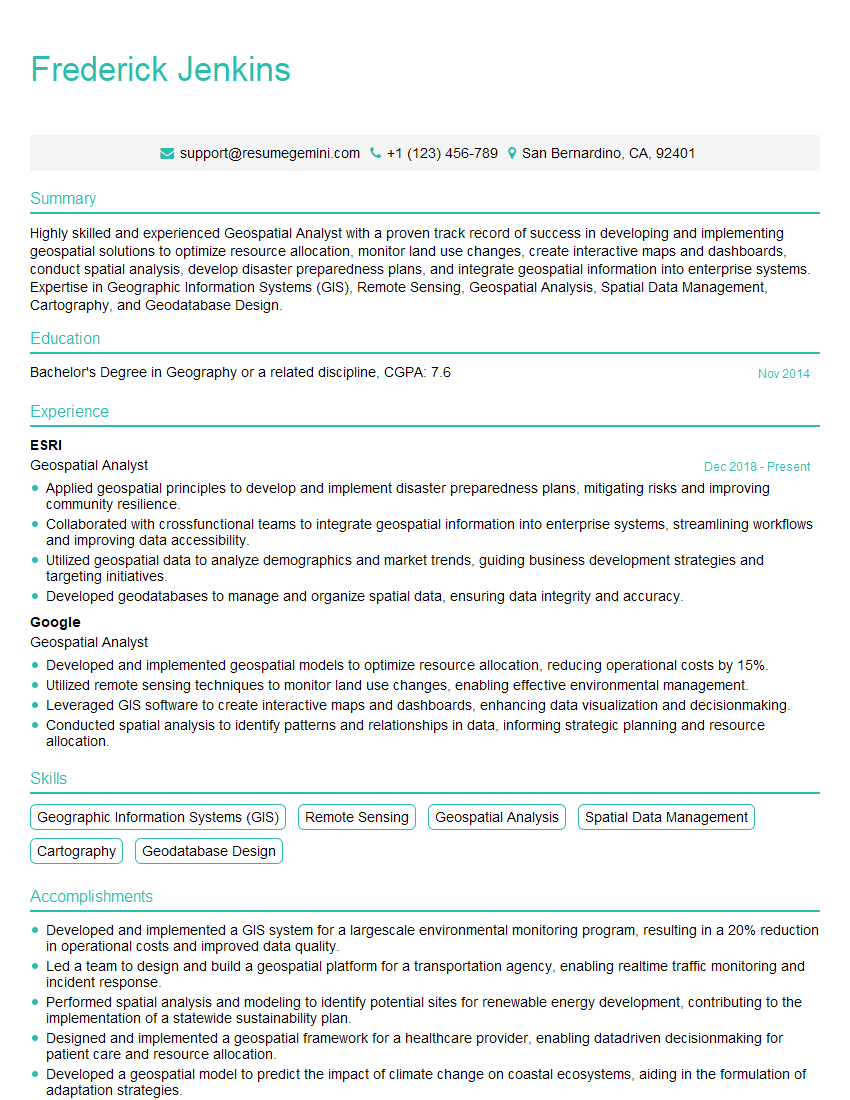Are you a seasoned Geospatial Analyst seeking a new career path? Discover our professionally built Geospatial Analyst Resume Template. This time-saving tool provides a solid foundation for your job search. Simply click “Edit Resume” to customize it with your unique experiences and achievements. Customize fonts and colors to match your personal style and increase your chances of landing your dream job. Explore more Resume Templates for additional options.

Frederick Jenkins
Geospatial Analyst
Summary
Highly skilled and experienced Geospatial Analyst with a proven track record of success in developing and implementing geospatial solutions to optimize resource allocation, monitor land use changes, create interactive maps and dashboards, conduct spatial analysis, develop disaster preparedness plans, and integrate geospatial information into enterprise systems. Expertise in Geographic Information Systems (GIS), Remote Sensing, Geospatial Analysis, Spatial Data Management, Cartography, and Geodatabase Design.
Education
Bachelor’s Degree in Geography or a related discipline
November 2014
Skills
- Geographic Information Systems (GIS)
- Remote Sensing
- Geospatial Analysis
- Spatial Data Management
- Cartography
- Geodatabase Design
Work Experience
Geospatial Analyst
- Applied geospatial principles to develop and implement disaster preparedness plans, mitigating risks and improving community resilience.
- Collaborated with crossfunctional teams to integrate geospatial information into enterprise systems, streamlining workflows and improving data accessibility.
- Utilized geospatial data to analyze demographics and market trends, guiding business development strategies and targeting initiatives.
- Developed geodatabases to manage and organize spatial data, ensuring data integrity and accuracy.
Geospatial Analyst
- Developed and implemented geospatial models to optimize resource allocation, reducing operational costs by 15%.
- Utilized remote sensing techniques to monitor land use changes, enabling effective environmental management.
- Leveraged GIS software to create interactive maps and dashboards, enhancing data visualization and decisionmaking.
- Conducted spatial analysis to identify patterns and relationships in data, informing strategic planning and resource allocation.
Accomplishments
- Developed and implemented a GIS system for a largescale environmental monitoring program, resulting in a 20% reduction in operational costs and improved data quality.
- Led a team to design and build a geospatial platform for a transportation agency, enabling realtime traffic monitoring and incident response.
- Performed spatial analysis and modeling to identify potential sites for renewable energy development, contributing to the implementation of a statewide sustainability plan.
- Designed and implemented a geospatial framework for a healthcare provider, enabling datadriven decisionmaking for patient care and resource allocation.
- Developed a geospatial model to predict the impact of climate change on coastal ecosystems, aiding in the formulation of adaptation strategies.
Awards
- Received the ESRI Special Achievement in GIS for developing an innovative geospatial model that optimized resource allocation for disaster response.
- Honored with the ASPRS Outstanding Achievement in Geospatial Science Award for a groundbreaking approach to land use mapping using remote sensing data.
- Recognized with the URISA Geospatial Excellence Award for creating a geospatial database that integrated multiple datasets and provided insights for urban planning.
- Received the GISCI GIS Professional of the Year Award for significant contributions to the field of geospatial intelligence.
Certificates
- GIS Professional (GISP)
- ArcGIS Desktop Associate
- ArcGIS Desktop Professional
- QGIS Certified User
Career Expert Tips:
- Select the ideal resume template to showcase your professional experience effectively.
- Master the art of resume writing to highlight your unique qualifications and achievements.
- Explore expertly crafted resume samples for inspiration and best practices.
- Build your best resume for free this new year with ResumeGemini. Enjoy exclusive discounts on ATS optimized resume templates.
How To Write Resume For Geospatial Analyst
- Highlight your technical skills and experience in GIS, remote sensing, and geospatial analysis.
- Showcase your ability to solve problems using geospatial data and develop effective solutions.
- Quantify your accomplishments with metrics and results to demonstrate the impact of your work.
- Tailor your resume to the specific requirements of the job you are applying for.
Essential Experience Highlights for a Strong Geospatial Analyst Resume
- Develop and implement geospatial models to optimize resource allocation and reduce operational costs.
- Utilize remote sensing techniques to monitor land use changes and enable effective environmental management.
- Leverage GIS software to create interactive maps and dashboards that enhance data visualization and decision-making.
- Conduct spatial analysis to identify patterns and relationships in data, informing strategic planning and resource allocation.
- Apply geospatial principles to develop and implement disaster preparedness plans, mitigating risks and improving community resilience.
- Collaborate with cross-functional teams to integrate geospatial information into enterprise systems, streamlining workflows and improving data accessibility.
- Utilize geospatial data to analyze demographics and market trends, guiding business development strategies and targeting initiatives.
Frequently Asked Questions (FAQ’s) For Geospatial Analyst
What is the role of a Geospatial Analyst?
A Geospatial Analyst uses geographic information systems (GIS) to analyze and visualize data related to the Earth’s surface. They use this data to solve problems and make decisions about land use, natural resources, and other environmental issues.
What are the skills and qualifications required to become a Geospatial Analyst?
Geospatial Analysts typically need a bachelor’s degree in geography, environmental science, or a related field. They also need to be proficient in GIS software and have experience with remote sensing and spatial analysis.
What are the job prospects for Geospatial Analysts?
The job outlook for Geospatial Analysts is expected to be good over the next few years. As businesses and governments increasingly rely on geospatial data to make decisions, the demand for qualified analysts will continue to grow.
What is the average salary for a Geospatial Analyst?
The average salary for a Geospatial Analyst in the United States is around \$65,000 per year.
What are some of the benefits of working as a Geospatial Analyst?
Geospatial Analysts enjoy a number of benefits, including the opportunity to work on challenging and rewarding projects, the chance to make a difference in the world, and the opportunity to work with cutting-edge technology.